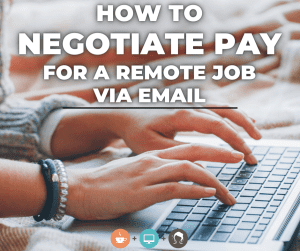How to Successfully Negotiate Pay for a Remote Job via Email

Remote work is great! With a flexible schedule, no dress code, and the ability to work anywhere, there are tons of benefits of working remotely. However, one thing that can be intimidating to some is negotiating their salary…digitally! Oftentimes, you will communicate with your employer via email, and asking for money via email can be very daunting. Trying to craft the perfect virtual message can be nerve-racking, and you might find yourself typing, re-typing, and typing again trying to get the best message down. That is why we have created a handy guide below on how to create an email that you can feel confident about to help you achieve the pay you want!
Research
Before you begin writing your email, research the position and what a typical pay level for it is commensurate with the experience you bring to the table. It’s best to ask for a small range versus an exact amount. For example, ask for $25-$30 per hour versus asking for exactly $33. Remember, this is a negotiation! You also should not offer a wide range such as $25-$45 because that leaves too many options available. Your rates need to reflect the value you bring to the table, so you should be choosing a common industry range that will cover your expenses and skills.
Don’t forget, you can also negotiate for other things outside of pay such as vacation time or even your schedule! Pay is certainly the most common thing asked about in email, but you can always ask for changes to any aspect of your job.
You can also research templates for emails that others have written for positions that are similar to yours. These templates can help you get a feel for how you should structure your email. Once you’ve researched this information, it’s time to write the email!
Sell
The number one thing to do is to sell yourself. You have your résumé and cover letter ready, so now it’s time to show that you can be an asset to the company. There are a few things you should do in your email in order to succeed:
- Talk about how excited you are about the opportunity
- Share relevant past work experience
- Explain what you can offer the company that they may not be able to find elsewhere
It’s a good idea to have the job description handy so that you can call out each piece of it in your email to demonstrate why you deserve a certain pay level. For example, if the job description asks that a candidate have 3 years of experience working as a virtual assistant, and you have 5 years of experience, call that out in your email and mention your extra levels of experience as to why you feel you would like to be on the higher end of the pay scale offered.
It can be easy to get lost in the weeds with all this information, though! Take your time. Write everything down you feel is relevant. Then go back and take information out. Keep your email short and to the point. You can just say you have 5 years of experience; you do not need to take time to list out all the places you worked and what you did at each, for example.
Proofread
You’ve researched pay, written your email, and now it is time to proofread it. Read it a few times to check for grammatical errors. It helps to read it out loud to yourself to catch any potential mistakes — and to make sure that it makes sense! You can also ask friends or family to read it to get their feedback. If you’ve spent a lot of time drafting this, make sure to step away from it for an hour or so before sending. Then you can look at it with fresh eyes one last time before hitting send.
Respond
Remember, this is a negotiation! An employer might immediately accept the range you asked for and offer you something in that. Other times they might want to try and talk you down from that range. Be prepared that they may not accept your first ask. If they come back with a number you are not happy with, respond professionally and again highlight what you bring to the company that others do not with your specific experiences. You can also cite sources here if the pay range is less than industry average, for example, to show the company why you are asking for a specific range.
You should also not be afraid to ask questions about the negotiation! Ask the company why they want to give you the amount they are offering. Ask if they provide raises in the future and what a timeline would look like for that. This is not one-sided — it’s a two-way conversation between you and the business to figure out what works for you both.
Have you successfully negotiated pay via email before? Tell us about it so we can share your tips with others!


















